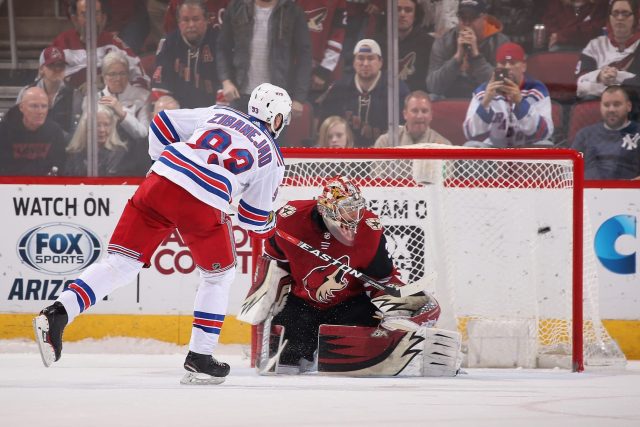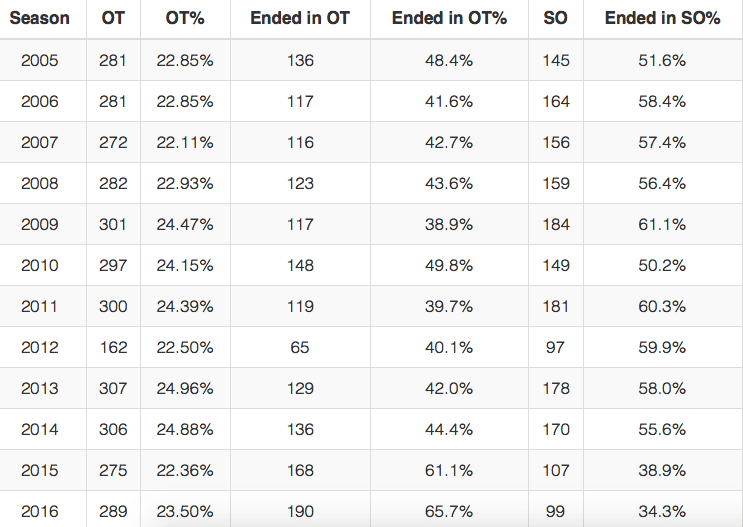The NHL needs to dump the shootout and revamp the points system

The NHL’s regular-season overtime and points system should be revamped. Awarding teams for losing no longer has the appeal it once did.
Ties have been part of the NHL since its inception. Each team would get a point at the end of regulation if the score was tied. The problem, over the years, was that ties sought of left fans with an empty feeling in their stomachs, leaving the game the same way they arrived—without a winner.
[sc name=”NHL Center” ]The Change in History
In the 1999-00 season, the NHL adopted a new way of concluding tied regular season hockey games. If a game ended in a tie, the two teams would play an additional five-minute, sudden-death overtime period. If at the conclusion of overtime, no team had scored, the result of the game would then be a tie, with each team getting one point in the standings.
Five years later, in 2005-06, the NHL made a drastic move, eliminating ties altogether. After the five minutes of overtime, the teams would go to a shootout. Teams would each get one point if the game was tied at the end of regulation, then they would battle for the other point in the five minute overtime period. If the game remained tied the game would enter a shootout. Now a drill that would normally conclude an average team practice for bragging rights would now decide the winner of an NHL game, which included a valuable “extra point” in the standings.
The NHL appeared to still have concerns about going to a shootout but still didn’t want to eliminate it. So in an effort to put more of an emphasis on winning in regulation time, the league decided to change the “win” category in the standings. With the creation of Regulation and Overtime Wins (ROW), teams would no longer have shootout wins count as a regular season wins for the purpose of tie-breakers in playoff seeding. The thought process here was to get teams to work harder to win in overtime as opposed to getting the win in the shootout.
With all of these new shootout rules, it seemed that games were still going through the five minutes overtime and the shootout was resolving more games. The shootout was not universally beloved. Some organizations liked it, but plenty of others would rather not have it as part of the game. In 2014-15, in an attempt to get more winners before the shootout would come into play, the league changed how the overtime would begin. Now teams would change ends between the end of the third and the overtime period as they do between the first-and-second periods.
Finally, at the start of the 2015-16 season, the NHL made another overtime rule change. Now the teams would skate three-on-three as opposed to four-on-four, as they had been using. Again, the hope was that the open ice would create more scoring opportunities and avoid the shootout.

The Numbers By Season

- In 2005, the first year of the shootout, 281 games went into overtime with 136 games ending in the overtime period (48.4 percent). 145 games went beyond overtime and ended in the shootout (51.6 percent)
- 2014-15, the season the league implemented the long change in overtime, 306 games needed overtime where 136 games were decided in the overtime period (44.4 percent), 170 games needed the Shootout to decide a winner (55.6 percent).
- With the start of the 2015-2016, when the league switched to three on three overtime periods, 168 games went to overtime (61.1 percent) with 107 games going into the shootout (38.9 percent).
In the last two seasons, the NHL has had a winner in overtime decided over 60 percent of the time. From 2005 to 2014, only 43.1 percent of the games that went into overtime was settled in overtime. The need for the shootout has decreased steadily over the last two seasons.
It seems that the league keeps trying to come up with different ways to have games decided in overtime, rather than the shootout. So why have the shootout at all?
Before we go further, understand the NHL, at one point wanted to go to a seven-minute overtime period, playing four-on-four for four minutes, then going to three-on-three for the final three minutes. They used this in the American Hockey League on a trial basis, but the National Hockey League Players Association wouldn’t agree to extend overtime, so the league implemented the three-on-three.
[sc name=”Generic Link Related” link=”https://elitesportsny.com/2018/01/04/nhl-all-star-game-fun-event-disrespectful-sport/” text=”The NHL All-Star Game: A Fun Event Or Disrespectful To The Sport?” ]How To Fix It
The NHL should eliminate the shootout and change the way points are handed out for wins. Teams getting one point if a game is tied at the end of regulation has become more of a strategy towards the end of a game. Too often a team will play it safe, knowing it will get at least one point in the standings if the game ends ties after 60 minutes of play. This prevents the teams from trying to get a regulation win.
Teams need to win more hockey games in regulation time. One possible way to get this done is to change the distribution of points in the standings.
- A team that wins in regulation time would receive three points.
- Overtime should be played three versus three until there is a winner. The winning team in overtime would get two points in the standings.
- The losing team in regulation or overtime would get zero points.
Winning a game in regulation has to be worth more than winning a game in overtime. A team should get something for an OT win, but not as much as a regulation victory. I have yet to figure out why a team should be awarded any points for losing a game.
Of course, there are a few issues with the points system suggested above. Playing until there is a winner in overtime might cause problems for the NHL’s television partners. They would probably not be happy with potential overlapping schedule issues that could occur. Just look at the overtime results for the last two seasons. If over 60 percent of the games were decided within the five-minute overtime period, one could say most games would be decided in the following five minutes.
Secondly, the NHL would have to get the NHLPA to sign on. As mentioned earlier, the NHLPA refused to extend overtime in 2015. This change would have to be negotiated within the Collective Bargaining Agreement between the NHL and the NHLPA.
The NHL seems to keep changing the overtime segment to help avoid going to a shootout, yet they won’t remove the shootout from the game entirely. This is something that needs to be resolved sooner than later.
A great game is played with plenty of scoring, hitting, and defense. Hitting and defense are removed from the equation in a shootout. An exhibition, something best saved for All-Star Weekend, should not be deciding games. End the madness now!
[sc name=”Rangers Link Next” link=”https://elitesportsny.com/2018/01/07/new-york-rangers-jesper-fast-start-receiving-top-six-minutes/” text=”Should Rangers Be Giving Jesper Fast Top-Six Minutes? ” ] [sc name=”NHL Section” ]A graduate of St. John's University class of '91. I have been a fan of the New York Rangers since the days of Peter Puck. Founder of Ranger Proud, the Facebook page that covers all news, notes, pre /post-game stats, and player quotes. I can be reached at Nyrfc12@gmail.com






